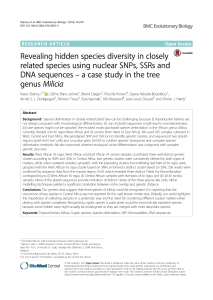Daïnou K. , Blanc-Jolivet C., Degen B., Kimani P., Ndiade-Bourobou D., Donkpegan A.S.L., Tosso F., Kaymak E., Bourland N., Doucet J.L., Hardy O.J.
Background: Species delimitation in closely related plant taxa can be challenging because (i) reproductive barriers are not always congruent with morphological differentiation, (ii) use of plastid sequences might lead to misinterpretation, (iii) rare species might not be sampled. We revisited molecular-based species delimitation in the African genus Milicia, currently divided into M. regia (West Africa) and M. excelsa (from West to East Africa). We used 435 samples collected in West, Central and East Africa. We genotyped SNP and SSR loci to identify genetic clusters, and sequenced two plastid regions (psbA-trnH, trnC-ycf6) and a nuclear gene (At103) to confirm species’ divergence and compare species delimitation methods. We also examined whether ecological niche differentiation was congruent with sampled genetic structure.
Results: West African M. regia, West African and East African M. excelsa samples constituted three well distinct genetic clusters according to SNPs and SSRs. In Central Africa, two genetic clusters were consistently inferred by both types of markers, while a few scattered samples, sympatric with the preceding clusters but exhibiting leaf traits of M. regia, were grouped with the West African M. regia cluster based on SNPs or formed a distinct cluster based on SSRs. SSR results were confirmed by sequence data from the nuclear region At103 which revealed three distinct ‘Fields For Recombination’ corresponding to (i) West African M. regia, (ii) Central African samples with leaf traits of M. regia, and (iii) all M. excelsa samples. None of the plastid sequences provide indication of distinct clades of the three species-like units. Niche modelling techniques yielded a significant correlation between niche overlap and genetic distance.
Conclusions: Our genetic data suggest that three species of Milicia could be recognized. It is surprising that the occurrence of two species in Central Africa was not reported for this well-known timber tree. Globally, our work highlights the importance of collecting samples in a systematic way and the need for combining different nuclear markers when dealing with species complexes. Recognizing cryptic species is particularly crucial for economically exploited species because some hidden taxa might actually be endangered as they are merged with more abundant species.
Consultez la notice complète de l’article sur ORBi

